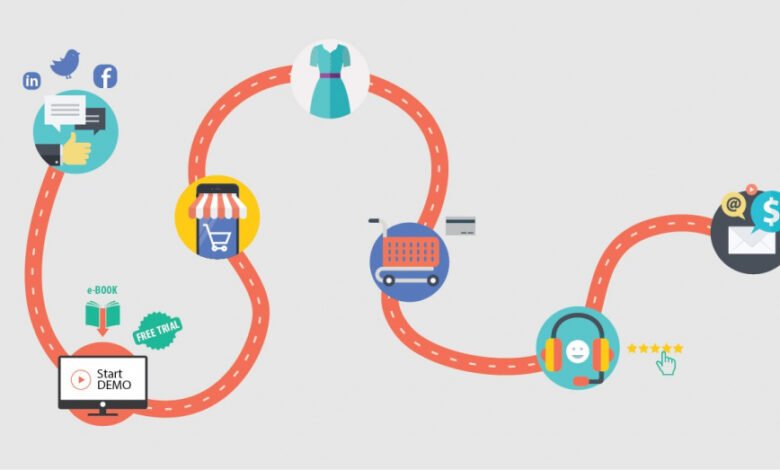How Customer Journey Mapping Tools Can Help You Personalize Your Marketing

Understanding your customers’ journey is crucial to creating effective marketing campaigns that resonate with their needs, behaviors, and preferences. Customer journey mapping tools provide a visual representation of the steps customers take as they interact with your brand, from initial awareness to post-purchase engagement. By leveraging these tools, businesses can gain insights into customer behavior, identify pain points, and create highly personalized marketing strategies.
In this blog, we’ll explore the benefits of customer journey mapping tools and how they can help businesses deliver personalized experiences that foster loyalty and drive conversions.
What is Customer Journey Mapping?
Customer journey mapping is the process of outlining every interaction a customer has with your brand across multiple touchpoints. A customer journey map helps businesses visualize the customer experience, highlighting key moments that influence decision-making.
Journey mapping tools take this process further by integrating data, analytics, and automation to create dynamic and detailed maps. These tools allow businesses to understand customer intent, preferences, and emotional responses at each stage of the journey, providing actionable insights to optimize marketing efforts.
The Importance of Personalization in Marketing
Personalization has become a cornerstone of successful marketing. Modern consumers expect tailored experiences that address their unique needs and preferences. Generic messaging no longer resonates, as customers are more likely to engage with brands that show a deep understanding of their individual journey.
By using customer journey mapping tools, businesses can:
- Understand customer motivations and pain points.
- Identify opportunities to deliver targeted messaging.
- Create campaigns that feel relevant and timely.
The result? Higher engagement rates, stronger customer relationships, and improved return on investment (ROI).
How Customer Journey Mapping Tools Work
Customer journey mapping tools combine data from various sources, such as website analytics, CRM systems, social media interactions, and customer feedback, to create a comprehensive view of the customer experience. These tools use data visualization to present the journey in a clear and actionable format.
Some common features of customer journey mapping tools include:
- Touchpoint Analysis: Identifying and analyzing interactions across email, social media, websites, and offline channels.
- Behavioral Insights: Understanding what actions customers take and why they take them.
- Segmentation Capabilities: Grouping customers based on demographics, behavior, or purchase history to tailor marketing strategies.
- Predictive Analytics: Using historical data to forecast future customer behavior and refine campaigns.
Benefits of Using Customer Journey Mapping Tools for Personalization
1. Understanding Customer Intent
Journey mapping tools provide insights into the motivations and goals of your customers. By analyzing customer actions at each touchpoint, businesses can determine why customers engage with their brand and what they hope to achieve.
For example, a mapping tool may reveal that customers often visit the FAQ page before purchasing. Armed with this insight, you can create marketing content that addresses common questions or highlights key product benefits, helping to move customers closer to conversion.
2. Identifying Pain Points
One of the most valuable aspects of journey mapping tools is their ability to pinpoint pain points in the customer experience. These are moments where customers face friction, confusion, or dissatisfaction.
For instance, a tool might show that a significant number of customers abandon their carts at the payment stage. This insight can guide you to simplify the checkout process, offer alternative payment methods, or send personalized reminders to complete the purchase.
3. Delivering Timely Messaging
Journey mapping tools help you identify the optimal timing for marketing messages. By understanding where customers are in their journey, you can send communications that align with their current needs.
For example:
- Awareness Stage: Use educational content, like blogs or videos, to introduce your brand.
- Consideration Stage: Offer comparisons, reviews, or free trials to help customers evaluate your product.
- Decision Stage: Send targeted promotions or limited-time offers to encourage immediate action.
4. Creating Omnichannel Experiences
Today’s customers interact with brands across multiple channels, often switching between devices and platforms. Journey mapping tools consolidate data from all these touchpoints to create a unified view of the customer experience.
This enables businesses to deliver consistent messaging and experiences across channels. For example, if a customer views a product on your website but doesn’t purchase, you can retarget them with personalized ads on social media or follow up with an email offering a discount.
5. Enhancing Customer Segmentation
Effective personalization starts with understanding your audience. Journey mapping tools allow you to segment customers based on shared characteristics or behaviors, enabling you to craft messages that resonate with specific groups.
For example:
- Segment 1: First-time visitors who need introductory offers or educational content.
- Segment 2: Loyal customers who respond well to exclusive rewards or VIP experiences.
- Segment 3: Cart abandoners who may convert with a reminder or incentive.
6. Tracking and Measuring Campaign Performance
Journey mapping tools often include analytics dashboards that track the performance of your campaigns. These insights help you understand what’s working and where improvements are needed.
For example, if a tool shows that email open rates are high but click-through rates are low, you might adjust your email design or CTA to improve engagement.
Key Customer Journey Mapping Tools for Marketers
Here are some popular customer journey mapping tools that can help businesses personalize their marketing:
- HubSpot: Offers robust CRM and marketing tools with journey mapping features to track customer interactions and tailor campaigns.
- Salesforce Journey Builder: A comprehensive platform for creating personalized customer journeys across multiple channels.
- Smaply: Specializes in visualizing customer journeys and identifying key touchpoints for optimization.
- UXPressia: Focuses on mapping user experiences with customizable templates and collaborative features.
- Google Analytics: Provides data on website behavior, helping you identify drop-off points and optimize user flow.
Best Practices for Using Customer Journey Mapping Tools
1. Start with Clear Goals
Define what you want to achieve with your journey mapping efforts. Whether it’s improving retention, increasing conversions, or enhancing customer satisfaction, clear goals will guide your strategy.
2. Involve Cross-Functional Teams
Customer journey mapping is most effective when insights are shared across departments, such as marketing, sales, and customer service. Collaboration ensures that every team contributes to and benefits from the insights.
3. Regularly Update Your Maps
Customer behaviors and preferences change over time. Regularly updating your journey maps ensures that your marketing strategies remain relevant and effective.
4. Test and Refine Campaigns
Use journey mapping tools to identify areas for testing and optimization. A/B testing different messaging, designs, or offers can help you determine what resonates most with your audience.
Conclusion
Customer journey mapping tools are invaluable for businesses looking to personalize their marketing efforts. By providing deep insights into customer behavior, pain points, and motivations, these tools empower marketers to create tailored campaigns that enhance the customer experience.
From improving segmentation to delivering timely messaging across channels, journey mapping tools transform the way businesses interact with their audiences. By leveraging these tools, you can build stronger connections, foster loyalty, and achieve greater success in your marketing efforts.





